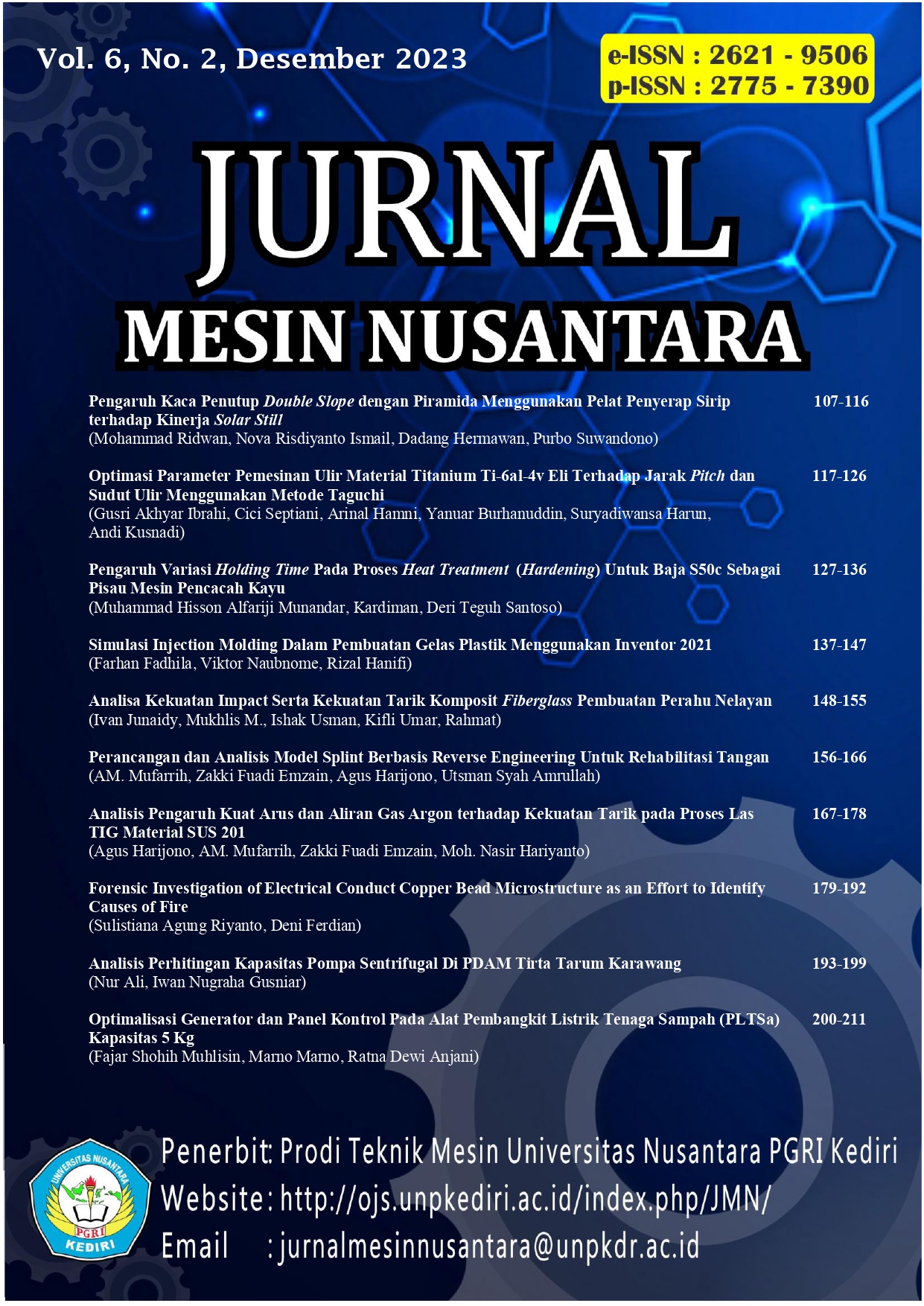Pengaruh Kaca Penutup Double Slope dengan Piramida Menggunakan Pelat Penyerap Sirip terhadap Kinerja Solar Still
DOI:
https://doi.org/10.29407/jmn.v6i2.19909Keywords:
solar still, penyerap sirip, model kaca penutup, produktivitas, efisiensiAbstract
Solar desalination technology is a technology that utilizes sunlight as the main energy resource to produce clean water through the process of heating seawater. This study compared solar stills using a double slope cover glass model with a pyramid model. The study used an experimental method to compare the cover glass of the double slope model and the pyramid model. The data taken are temperature, solar radiation intensity and water productivity. The thickness of the water above the basin is 1 cm. The study resulted in the highest productivity and efficiency of solar stills using the highest double slope model cover glass of 2,780 liters and an efficiency of 37.79% compared to solar stills using pyramid model cover glass with a productivity of 2,580 liters and an efficiency of 35.16%.
Downloads
References
K. B. A. Walangare, A. S. M. Lumenta, J. O. Wuwung, and B. A. Sugiarso, “Rancang Bangun Alat Konversi Air Laut Menjadi Air Minum Dengan Proses Destilasi Sederhana Menggunakan Pemanas Elektrik,” e-Jurnal Tek. Elektrodan Komput., 2013.
H. Herawati, Kartini, A. A. Akbar, and T. Abdurrahman, “Strategy for realizing regional rural water security on tropical peatland,” Water (Switzerland), vol. 13, no. 18, 2021.
N. Carrard, T. Foster, and J. Willetts, “Groundwater as a source of drinking water in southeast Asia and the Pacific: A multi-country review of current reliance and resource concerns,” Water (Switzerland), vol. 11, no. 8, 2019.
M. Anggara, D. Widhiyanuriyawan, and M. N. Sasongko, “Pengaruh penggunaan pasir besi pada Heat Absorber Plate Terhadap Produktifitas dan Efisiensi Solar Destilation,” Senas Pro, pp. 345–353, 2016.
D. Hermawan, N. R. Ismail, P. Suwandono, and F. D. Anggraeni, “Pengaruh Penambahan Media Pendingin Nitrogen Pada Dinding untuk Menigkatkan Kinerja Solar Still Double Slope ( Energi Dan Eksergi )*,” vol. 14, no. September, pp. 19–28, 2023.
N. R. Ismail, D. Hermawan, P. Suwandono, and L. H. Wicaksono, “Investigation of Performance of Stone Fin Solar Still Absorber by Water Depth Variations,” vol. 12, no. August, pp. 159–170, 2023.
N. R. Ismail, P. Suwandono, D. Hermawan, and F. D. Anggraeni, “Pemanfaatan dinding sebagai permukaan kondensasi untuk meningkatkan kinerja solar still double slope,” Turbo J. Progr. Stud. Tek. Mesin, vol. 12, no. 1, pp. 1–9, 2023.
S. L. Wawan.S Damanik, M.A siregar, “Kajian Pengaruh Ketebalan Kaca Evaporator Terhadap Energi Yang Diserap Kolektor Pada Proses Desalinasi Air Laut,” J. Rekayasa Mater. Manufaktur dan Energi http//jurnal.umsu.ac.id/index.php/RMME, vol. 2, no. 2, pp. 131–139, 2019.
D. A. Bara, Gusnawati, and Nurhayati, “Pengaruh Sudut Kaca Penutup dan Jenis Kaca terhadap Efisiensi Kolektor Surya pada Proses Destilasi Air Laut,” Lontar J. Tek. Mesin Undana, vol. 03, no. 02, pp. 01–10, 2016.
N. K. Caturwati, Y. Yusuf, I. Rosyadi, and A. F. Almarwan, “Comparison of the Effectiveness of 45˚ and 60˚ Cover Angle on the Production of Clean Water on Double Slope Solar Distilations,” vol. 3, no. 02, pp. 59–69, 2020.
A. W. Krisdiarto, A. Ferhat, A. W. Krisdiarto, and M. P. Bimantio, “Penyediaan Air Bagi Masyarakat Pesisir Terdampak Kekeringan dengan Teknologi Desalinasi Air Laut Sederhana,” DIKEMAS (Jurnal Pengabdi. Kpd. Masyarakat), vol. 4, no. 2, pp. 25–31, 2020.
S. Vala and B. Kanabar, “Solar Distillation Based on Pyramid Shape Solar Still-A Review,” J. Res., vol. 3, no. 3, pp. 1–4, 2017.
I. I. Patunrengi, M. L. Said, and I. Artikel, “Desain Dan Konstruksi Penyuling Air Asin Menjadi Air Tawar (Solar Still) Yang Mudah, Murah Dan Memiliki Efisiensi Tinggi,” vol. 7, no. 2, pp. 175–184, 2020.
K. H. Nayi and K. V. Modi, “Pyramid solar still: A comprehensive review,” Renew. Sustain. Energy Rev., vol. 81, no. July 2017, pp. 136–148, 2018.
Downloads
Published
Issue
Section
License
Authors who publish with this journal agree to the following terms:
- Copyright on any article is retained by the author(s).
- The author grants the journal, right of first publication with the work simultaneously licensed under a Creative Commons Attribution License that allows others to share the work with an acknowledgment of the work’s authorship and initial publication in this journal.
- Authors are able to enter into separate, additional contractual arrangements for the non-exclusive distribution of the journal’s published version of the work (e.g., post it to an institutional repository or publish it in a book), with an acknowledgment of its initial publication in this journal.
- Authors are permitted and encouraged to post their work online (e.g., in institutional repositories or on their website) prior to and during the submission process, as it can lead to productive exchanges, as well as earlier and greater citation of published work.
- The article and any associated published material is distributed under the Creative Commons Attribution-ShareAlike 4.0 International License












